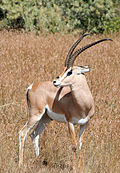Genus of mammals
| Nanger | |
|---|---|
 | |
| Grant's Gazelle (Nanger granti) | |
| Scientific classification | |
| Kingdom: | Animalia |
| Phylum: | Chordata |
| Class: | Mammalia |
| Order: | Artiodactyla |
| Family: | Bovidae |
| Subfamily: | Antilopinae |
| Tribe: | Antilopini |
| Genus: | Nanger Lataste, 1885 |
| Type species | |
| Antilope mhorr [1] Bennett, 1833 | |
Nanger is a genus of antelopes, commonly called gazelles. It was originally considered a subgenus within the genus Gazella , but has since been elevated to genus status. The three living species within the genus Nanger are:
| Image | Scientific name | Common name | Distribution |
|---|---|---|---|
 | Nanger dama | Dama gazelle | Chad, Mali, and Niger |
 | Nanger granti | Grant's gazelle | northern Tanzania to South Sudan and Ethiopia, and from the Kenyan coast to Lake Victoria |
 | Nanger soemmerringii | Soemmerring's gazelle | Horn of Africa |